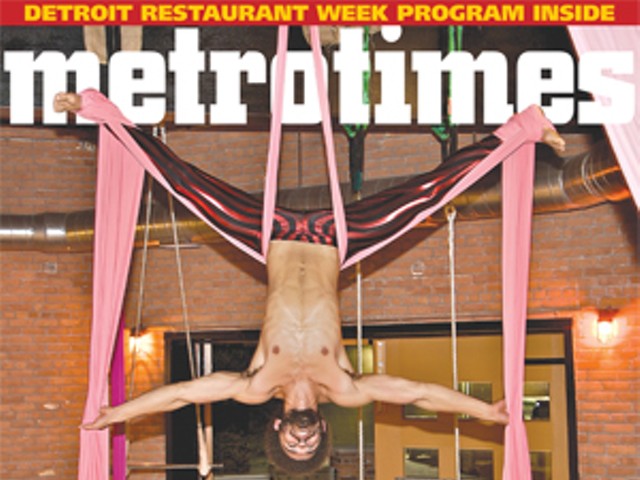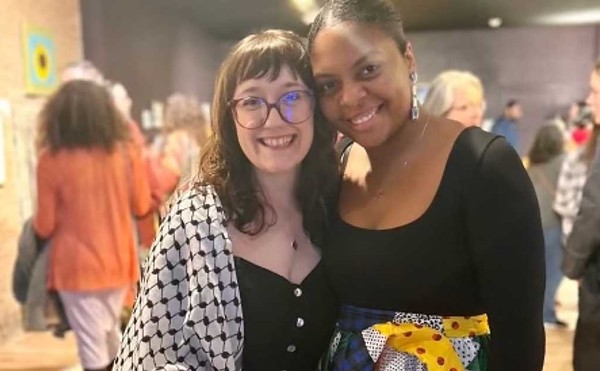It began last winter as a scribbled idea on a long sheet of paper, one of many thoughts that burst out with others, adding to the list of possibilities. This list was the result of one of many of Broken City Lab's regular brainstorming sessions for the group's next big project. These "projects," as they refer to them, are really art disguised as activism, or perhaps vice-versa.
Instead of protest and rallying, Broken City Lab uses art in their mission to reinvigorate both the physical and emotional landscapes in their hometown of Windsor, Ontario. "I'm a believer in taking action by doing things that motivate you and change the environment around you," says Justin Langlois, Research Director of the Lab.
Among the abandoned houses, boarded up businesses, and failing industries of what he calls "Canada's Detroit," the group is creatively confronting the decay taking place around them. That's to say, Broken City Lab believes that there are opportunities in a struggling city to alter the status quo. It's a similar mission shared by artists from shrinking cities the world over, such as Detroit, Leipzig, Manchester, and Ivanovo; those metropolises featured in the 2007 Shrinking Cities exhibition at the Museum of Contemporary Art Detroit.
As a Detroiter, it's inspiring to see inventive ideas growing, not just in our city, but in Windsor.
Lab co-founder Danielle Sabelli delves further into the Lab's mission: "What we do is geared toward creating a more positive view of Windsor; we're hoping to encourage the people here to take a stand and reclaim their city."
As for the ways in which Broken City Lab looks to achieve this goal, the group "tactically disrupts and engages" the community through a series of projects that merge art and social activism. This summer, hundreds of Windsor municipal employees went to the picket lines to protest cuts to post-retirement health benefits for new union members, leaving trash uncollected and city parkland growing wild, among other things. During the 19-week strike, the Lab designed, fabricated and installed a number of quirky, quasi-official looking signs announcing that the city's unkempt parks were now "Naturalized Areas."
Langlois says it was a tongue-in-cheek way of reminding Windsor residents that even a glimpse of wild, open space was a refreshing and beautiful site in a city. A closer look at each of these bright blue placards reveals another, more subliminal side to the project's purpose. Because it was created to address a specific situation in Windsor, the Motor City skyline appears in a thick black silhouette in the sign's background, as if to subtly remind Windsorites that Detroit is a part of their landscape, whether or not they choose to embrace it.
Langlois calls the addition of the skyline an intentional choice. The simple silhouette brings us to a subject close to his, and the group's heart: communication with Detroit. Speaking from experience, Langlois is quick to comment on the estranged relationship between the city's residents, an alienation seen in the relative lack of cooperation between artists, community activists, and business leaders, given our physical proximity.
"I think the physical border lends itself to the mental," says Brandon Walley, a local filmmaker. "It's much easier to say 'I'm just going to go to an art opening at the Cass Cafe then undertake this almost monumental journey across the border ... but I'd like to see the relationship change." Further border restrictions, which began this summer, seem to have only exacerbated things.
And while high unemployment rates, home foreclosures, and empty factories continue to plague both cities, Langlois says the need to communicate is desperate. Hence the idea for a large-scale message from Windsor's citizens to Detroit's — a billboard-like communiqué announcing that Windsor is still alive and would even like to have a conversation with its similarly downtrodden cousin. The idea, involving what is essentially a giant light projector, came after the group rejected the idea of using actual billboards, but instead took a cue from the experimental urban art of the Graffiti Research Lab, which pioneered the use of LEDs to produce temporary street art.
The projection project's official title, Cross-Border Communication, is still in beginning stages of conception. As Broken City Lab envisions, it will be a weekly message displayed to Detroit from Windsor using an enormous 6,000-lumens light projector, stationed in Windsor's downtown and projecting against one of the city's office buildings. Each month, a new message will be broadcast in an attempt to reconnect two cities struggling to find their future in the post-industrial landscape.
"That's why we wanted to start the project; there's this great city over there and this great city over here and we need to start a dialogue," Sabelli says. "The best way either city can sort of truck on though is by talking."
Langlois adds that he's not sure what happens after the conversation begins; all he's truly hoping for is that someone over here will see the message and think about what might be happening in Windsor. He says the projection project's intent is to connect us as more than victims of an economic collapse; his hope is that we acknowledge our situation, and then, perhaps, see each other simply as people with similar passionate hopes for our community's future.
Windsor has always been in the shadow of Detroit, touched by the ups and downs of the Big Three. For some, each city is a sore spot on the psyches of our respective countries, an embarrassment of the nations' pasts in manufacturing. And while both communities, but especially Detroit, continue to bleed population to states and provinces with more jobs, mass transit, and regional cooperation, perhaps a previously unseen opportunity to grow our ranks as activists, writers, artists, or even as a region-in-spirit, rests with the residents of our rust-belt sister city.
But until we take notice, the members of Broken City Lab will continue to plan ways to send us light though dark; the first message being, Langlois says, the most direct: "We're in this together."
For specific information about this project, see brokencitylab.org.





